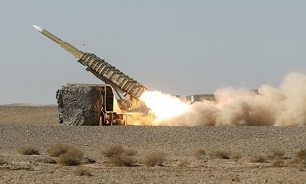Iran’s Mersad, Tabas Missile Systems Target Hypothetical Enemy Drones in Drills
 The two indigenized missile systems successfully destroyed the aggressive drones of hypothetical enemy which were flying at mid altitude after being traced during the joint wargames by the Army and the IRGC codenamed 'Modafe'an-e Aseman-e Velayat 99' (Guardians of Velayat's Sky-99).
The two indigenized missile systems successfully destroyed the aggressive drones of hypothetical enemy which were flying at mid altitude after being traced during the joint wargames by the Army and the IRGC codenamed 'Modafe'an-e Aseman-e Velayat 99' (Guardians of Velayat's Sky-99).
Fire operations and rapid movement of defense systems from one location to other locations were among the measures taken in this stage of the drills, which were successfully carried out with the aim of preventing the hypothetical enemies to find the location of defense systems.
Earlier today, the Iranian Army and IRGC forces exercised destruction of hypothetical enemy targets in high and mid altitudes by the powerful home-made Third of Khordad and Khordad 15 air defense systems during the joint aerial wargames on Wednesday.
The indigenized air defense systems of the IRGC Aerospace Force named Third of Khordad and the Army’s air defense shield named Khordad 15 successfully destroyed the aggressive targets during their joint wargames.
Also at this stage of the drills which started on Wednesday, hypothetical enemy drones tried to disrupt the function of the Air Defense’s radars by jamming to test their sustainability and capability to continue operations in electronic warfare conditions.
Meantime, electronic jamming operations on the aggressive drones to prevent their flying over the drills zone were successfully carried out.
Iran in June 2019 unveiled a new home-made state-of-the-art missile defense system named 'Khordad 15' which is equipped with passive phased array radar system for detecting fighter jets, stealth targets and cruise missiles.
The missile defense system was unveiled in a ceremony participated by Iranian Defense Minister Brigadier General Amir Hatami and Commander of the Iranian Army's Khatam ol-Anbiya Air Defense Base Brigadier General Alireza Sabahi Fard in Tehran.
Elaborating on the features and capabilities of the defense shield, General Hatami said that it can trace targets, including fighter jets and enemy drones, 150km away and intercept them at a range of 120km.
"It can also trace stealth targets in areas 85km in distance, and destroy them at a distance of 45km," he added.
General Hatami said that the missile defense system can trace, engage, and destroy 6 targets simultaneously, enjoys high mobility and can be prepared for operation in less than 5 minutes.
"The system is equipped with (passive) phased-array radar system with a multiple-target-engagement capability. It also has separate launch pads, and operates with Sayyad 3 missiles," he underlined.
Also, Iran's powerful defense system intercepted an intruder US Navy spy drone, MQ4-C Triton, over Iran's territorial waters on June 20, 2019.
The IRGC shot down a US Navy’s Northrop Grumman MQ4-C Triton drone that had entered Iranian airspace in the Gulf Oman to gather intelligence, using Sevvom Khordad indigenous surface-to-air missile system.
The United States had confirmed that one of its reconnaissance planes was shot down by Iranian air defenses, but denied that it intruded into Tehran’s airspace at the time.
Commander of the IRGC Aerospace Force Brigadier General Amir Ali Hajizadeh said at the time that his forces could have also shot down a US P8 aircraft with 35 on board which was violating Iran’s airspace, but decided to shoot down the drone to only send a message to Washington.
“We intended to send a message to American terrorists in the region,” Brigadier General Hajizadeh said on June 21, 2019, adding that his forces had also traced a military P8 aircraft violating the airspace of Iran.
“Along with the American drone was an American P8 aircraft with 35 on board, and it was also violating our airspace and we could have downed it too,” he said, adding, “But we did not do (shoot down) it, because our aim was to warn the terrorist forces of the US.”
General Hajizadeh also stressed on June 22, 2019, that Iran was not after war but was fully ready to defend itself, adding that the fate of the downed US spy drone was waiting for any intruding flying object.
“Our response to anything trespassing Iranian territory is like this, and if such acts of aggression are repeated, our response will also be the same," General Hajizadeh said.
“We don’t embrace war but we are ready to fully defend the country,” he said.
"We possess a collection of US drones which is a proof that US has violated Iran’s airspace and shows that they don’t want to respect the international law,” General Hajizadeh said.
“If such an aggression is repeated, we will add other US (military) products to complete this collection,” he noted.
“The US measure was in violation of international law and we acted according to our legitimate responsibility,” General Hajizadeh said, adding, “It is possible that a US general or some operators were behind this American aggression, we don’t know that. But that measure (intruding into Iranian airspace) is a violation of international aviation rules by a spy drone which then received our natural response."
Meantime, IRGC Commander Major General Hossein Salami stressed that the move should alert Washington officials to stay away.
The incident sent "a clear message" to the US and other enemies that Iran will show a firm and crushing response to any aggression, he stated.
"Borders are our red lines and any enemy which violates them will not go back home and will be annihilated. The only way for enemies is to respect Iran's territorial integrity and national interests," the major general noted.
message end/